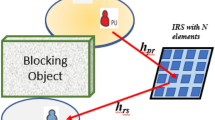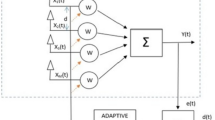Abstract
Multiple-input multiple-output (MIMO) technique plays a key role in improving the spectrum and power efficiency in future mobile communication systems. Exploiting a unified MIMO transmission scheme that can adapt with various channel conditions is well motivated both in theory and practical applications. An eigen-mode based closed-loop MIMO transmission over frequency selective fading MIMO channels, which considers receive correlation, transmit correlation and line of sight (LOS) components, is investigated by maximizing the upper bound of channel capacity under the assumption that the channel is partially known at the transmitter and perfectly known at the receiver. Based on the eigen-mode transmission, several key techniques including linear precoding, stream selection, virtual spatial hopping and online capacity estimation are proposed, and a unified MIMO transmission scheme is established. Both computer simulation and field test results show that the proposed scheme can significantly improve the spectral efficiency and link reliability under various channel conditions.
Similar content being viewed by others
References
RECOMMENDATION ITU-R M.1645. Framework and overall objectives of the future development of IMT-2000 and systems beyond IMT-2000. 2003
You X H, Chen G A, Chen M, et al. Toward beyond 3G: the FuTURE project of China. IEEE Commun Mag, 2005, 43(1): 70–75
Stuber G L, Barry J R, Mclaughlin S W, et al. Broadband MIMO-OFDM wireless communications. Proc IEEE, 2004, 92(2): 271–294
Paulraj A, Nabar R, Gore D. Introduction to Space-Time Wireless Communications. Cambridge: Cambridge University Press, 2003
Gao X Q, You X H, Jiang B, et al. Generalized multi-carrier transmission technique for beyond 3G mobile communications. Proc of IEEE PIMRC, 2003, 2: 972–976
Foschini G J, Gans M J. On limits of wireless communications in a fading environment when using multiple antennas. Wireless Pers Commun, 1998, 6(3): 311–335
Telatar I E. Capacity of multi-antenna Gaussian channels. European Trans Telecommun, 1999, 10(6): 585–595
Shiu D S, Foschini G J, Gans M J, et al. Fading correlation and its effects on the capacity of multielement antenna systems. IEEE Trans Commun, 2004, 48(3): 502–513
Forenza A, McKay M R, Heath Jr R W, et al. Switching between OSTBC and spatial multiplexing with linear receivers in spatially correlated MIMO channels. Proc of IEEE VTC, 2006, 3: 1387–1391
Venkatesan S, Simon S H, Valenzuela R A. Capacity of a Gaussian MIMO channel with nonzero mean. Proc of IEEE VTC, 2003, 3: 1767–1771
Hoesli D, Kim Y H, Lapidoth A. Monotonicity results for coherent MIMO Rician channels. IEEE Trans Inf Theory, 2006, 51(12): 4334–4339
Bolcskei H, Borgmann M, Paulraj A J. Impact of the propagation environment on the performance of space-frequency coded MIMO-OFDM. IEEE J Select Areas Commun, 2003, 21(3): 427–439
Jorswieck E A, Boche H. Optimal transmission strategies and impact of correlation in multiantenna systems with different type of channel state information. IEEE Trans Signal Process, 2004, 52(12): 3440–3453
Narula A, Lopez M J, Trott M D, et al. Efficient use of side information in multiple antenna data transmission over fading channels. IEEE J Select Areas Commun, 1998, 16(8): 1423–1436
Visotsky E, Madhow U. Space-time Transmit Precoding with Imperfect Feedback. IEEE Trans Inf Theory, 2001, 47(6): 2632–2639
Jorswieck E A, Boche H. Channel capacity and capacity-range of beamforming in MIMO wireless systems under correlated fading with covariance feedback. IEEE Trans Wireless Commun, 2004, 3(5): 1543–1553
Ho T S, Sakagnchi K, Araki K. Performance analysis of MIMO eigenmode transmission system under realistic channel and system conditions. Proc of IEEE VTC, 2004, 2: 708–712
Xiao C S, Zheng Y R. Ergodic capacity of doubly selective Rayleigh fading MIMO channels. Proc of IEEE WCNC, 2004, 1: 345–350
Jin S, Gao X Q, You X H. On the ergodic capacity of rank-1 Ricean-fading MIMO channels. IEEE Trans Inf Theory, 2007, 53(2): 502–517
Chung S T, Lozano A, Huang H C, et al. Approaching the MIMO capacity with a low-rate feedback channel in V-BLAST. EURASIP J Appl Signal Process, 2004, 2004: 762–771
Wang D M, Gao X Q, You X H. Low complexity turbo receiver for multi-user STBC block transmission systems. IEEE Trans Wirel Commun, 2006, 5(10): 2625–2632
Wang W J, Gao X Q, Wu X F, et al. Dual-turbo receiver architecture for turbo coded MIMO-OFDM systems. In: Proc of IEEE ICC 2009, Dresden, Germany, 2009
Biguesh M, Gershman A B. Training-based MIMO channel estimation: a study of estimator tradeoffs and optimal training signals. IEEE Trans Signal Process, 2006, 54(3): 884–893
Gao X Q, Jiang B, You X H, et al. Efficient channel estimation for MIMO single-carrier block transmission with dual cyclic timeslot. IEEE Trans Commun, 2007, 55(11): 2210–2223
Jiang B, Wang W J, Gao X Q. Polynomial-based noise variance estimation for MIMO-SCBT systems. IEEE Signal Proc Lett, 2009, 16(6): 497–500
Author information
Authors and Affiliations
Corresponding authors
Additional information
Supported by the National Natural Science Foundation of China (Grant Nos. 60572072, 60496311), the National High-Tech Research & Development Program of China (Grant No. 2006AA01Z264) the National Basic Research Program of China (Grant No. 2007CB310603), the Doctor Subject Foundation of China (Grant No. 20060286016), the National Science and Technology Major Project of China (Grant Nos. 2009ZX03003-005, 2008ZX03003-005), and the International Science and Technology Cooperation Program of China (Grant No. 2008DFA12090)
Rights and permissions
About this article
Cite this article
Gao, X., You, X., Jiang, B. et al. Unifying eigen-mode MIMO transmission. Sci. China Ser. F-Inf. Sci. 52, 2269–2278 (2009). https://doi.org/10.1007/s11432-009-0217-3
Received:
Accepted:
Published:
Issue Date:
DOI: https://doi.org/10.1007/s11432-009-0217-3




